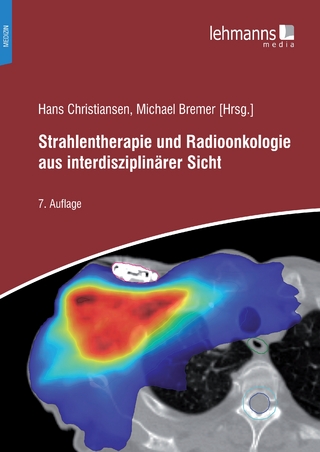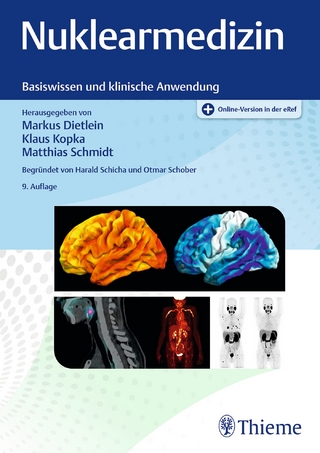
Diagnostic Nuclear Medicine
Springer Berlin (Verlag)
978-3-540-00690-9 (ISBN)
David Hamilton, der in Großbritannien geborene Fotograf, arbeitete seit den fünfziger Jahren in Paris u. a. als Grafikdesigner bei der Zeitschrift Elle. Seine Fotografien veröffentlichte er in Kultzeitschriften wie Twen. Er lebt heute über siebzigjährig in Südfrankreich.
I Radiation.- I.1 Radioactivity.- I.2 Radiopharmaceuticals.- I.3 Biological Effects of Radiation.- I.4 Protection of the Community.- I.5 Protection of the Patient.- II Detection Systems.- II.1 Radiation Detection.- II.2 Non-Imaging.- II.3 Single Photon Planar Imaging.- II.4 Single Photon Tomographic Imaging.- II.5 Dual Photon Imaging.- II.6 Image Presentation.- II.7 Computers and Communications.- III Clinical Procedures.- III.1 Non-Imaging Studies.- III.2 Single Photon Planar Imaging.- III.3 Single Photon Tomographic Imaging.- III.4 Dual Photon Imaging.- III.5 Image Processing and Analysis.- IV Quality Assurance.- IV.1 Quality Assurance.- IV.2 Radiopharmaceutical.- IV.3 Non-Imaging.- IV.4 Single Photon Planar Imaging.- IV.5 Single Photon Tomographic Imaging.- IV.6 Dual Photon Imaging.- IV.7 Image Presentation.- IV.8 Computer.- V Appendices.- V.1 Radionuclide Decay Characteristics.- V.2 Units.- V.3 Collimator Details.- V.4 GFR Single Sample Equations.- V.5 Typical Acquisition and Processing Protocols for Single Photon Investigations.
From the reviews:
RAD Magazine, June, 2005:
The material is presented in a very clear and readable manner.
The broad range of material on the topic is dealt with clearly and concisely.
Overall, this book contains a very clear presentation of the 'core of knowledge' required in nuclear medicine.
It admirably fulfils the aims set out by the author and would be an invaluable text for trainees in physics, and radiography and radiology. It would also be an excellent addition to the nuclear medicine department library as it contains a wealth of information that experienced practitioners need to refer to from time to time.
As is customary with books produced by this publisher, the quality of the printing and binding is excellent.
"The aim of this book is to reacquaint practitioners with the fundamental principles of nuclear medicine so that investigative techniques may be optimised. ... presented in a very clear and readable manner. ... Quality control is also highlighted as an important issue. The broad range of material on the topic is dealt with clearly and concisely. ... would be an invaluable text for trainees in physics and radiography and radiology. It would also be an excellent addition to the nuclear medicine department library ... ." (Dr. M Casey, RAD Magazine, June, 2005)
"The book provides in plain terms, the comprehensive physics needed for clinical practice in diagnostic nuclear medicine. It bridge a gap between physicians and basic scientists working within nuclear medicine as a unique community. ... This book is essential for nuclear medicine specialists, residents and health physicists ... . This is a book of very high educational value." (G. L. Lucignani, Quarterly Journal of Nuclear Medicine and Molecular Imaging, Vol. 49 (3), 2005)
| Erscheint lt. Verlag | 14.5.2004 |
|---|---|
| Co-Autor | P.J. Riley |
| Zusatzinfo | XII, 465 p. |
| Verlagsort | Berlin |
| Sprache | englisch |
| Maße | 155 x 235 mm |
| Gewicht | 1010 g |
| Themenwelt | Medizin / Pharmazie ► Medizinische Fachgebiete ► Onkologie |
| Medizinische Fachgebiete ► Radiologie / Bildgebende Verfahren ► Nuklearmedizin | |
| Medizinische Fachgebiete ► Radiologie / Bildgebende Verfahren ► Radiologie | |
| Schlagworte | Computer • Diagnosis • diagnostic radiology • Imaging • medical physics • Nuclear Medicine • Nuclear Medicne • Nuklearmedizin • quality • Radiation • Radiaton Oncology |
| ISBN-10 | 3-540-00690-7 / 3540006907 |
| ISBN-13 | 978-3-540-00690-9 / 9783540006909 |
| Zustand | Neuware |
| Haben Sie eine Frage zum Produkt? |
aus dem Bereich


